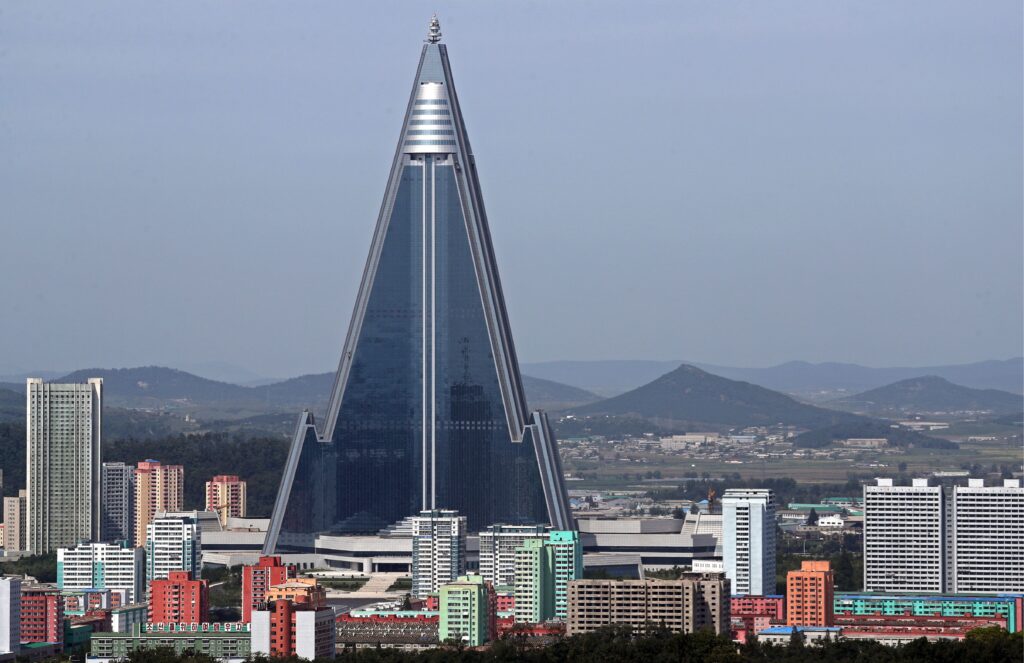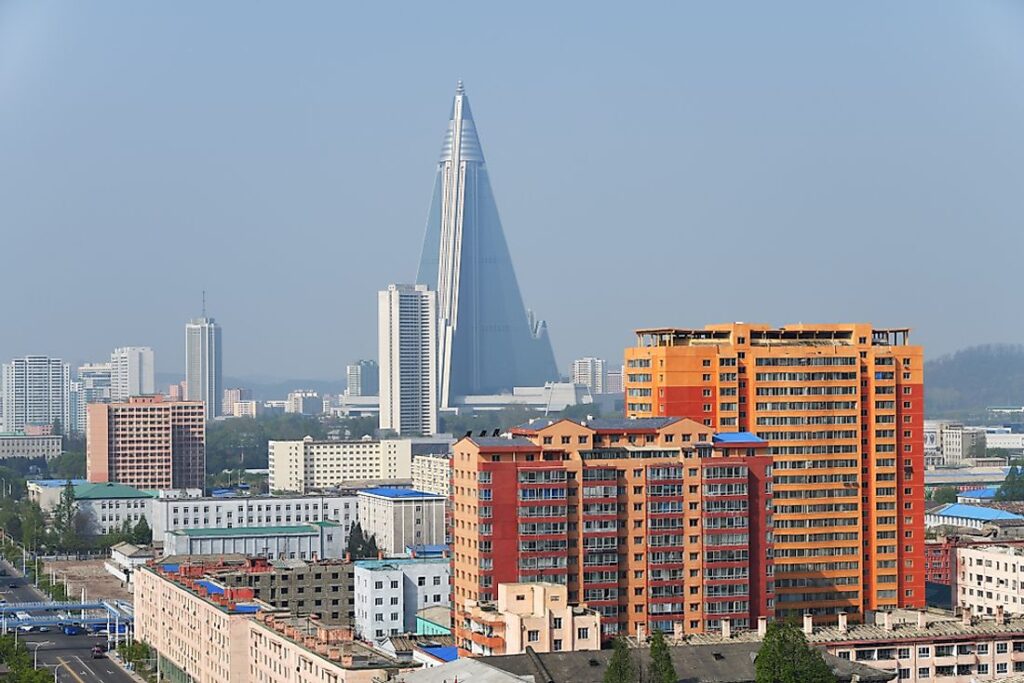Ryugyong Hotel: Inside North Korea’s Mysterious Pyramid Skyscraper (2025 Status Update)
Towering 330 meters above Pyongyang stands the world’s tallest unoccupied building – the infamous Ryugyong Hotel. This pyramid-shaped concrete colossus has dominated North Korea’s capital skyline for over three decades, yet has never hosted a single guest. As of 2025, the exterior now serves as an enormous LED display showing propaganda animations nightly, while its interior remains largely unfinished. Originally conceived as a symbol of prosperity, the 105-story “Hotel of Doom” instead became an inadvertent monument to the regime’s economic challenges.
Contents
Current Status (2025 Update)
Is the Ryugyong Hotel open? No, as of May 2025, the Ryugyong Hotel remains unopened to the public with an unfinished interior, despite periodic rumors about completion dates.
The most significant recent development is the massive LED display system installed on the building’s exterior in 2018. This state-of-the-art screen, which may be the largest in the world, illuminates each evening from 7-10 PM with North Korean propaganda films, patriotic animations, and national symbols.
While the glass exterior cladding was completed in 2011, reliable sources indicate the interior remains largely unfinished. No functioning elevators, rooms, or facilities are currently operational, though limited interior construction has been observed periodically.

Essential Facts About the Pyramid Skyscraper
Location
Pyongyang, North Korea
Height
330 meters (1,080 feet)
Floors
105 stories
Construction Period
1987-1992, resumed 2008-2011
Current Status
Exterior complete, interior unfinished
Nicknames
“Hotel of Doom,” “Phantom Hotel”
World Records
Tallest unoccupied building (Guinness)
Architectural Style
Futuristic, Neo-Futurist, Brutalist
Unique Architectural Design
The Ryugyong Hotel’s distinctive silhouette is instantly recognizable, featuring three symmetrical wings that slope at a precise 75-degree angle, converging into a pointed cone. This dramatic pyramidal structure wasn’t merely an aesthetic choice but addressed specific engineering challenges of building with concrete rather than steel.
Remarkable Design Elements:
- Triangular Footprint: The three wings create a triangular floor plan that provides structural stability for the immense height
- Sloped Facades: The 75-degree slope of each wing creates the dramatic pyramid silhouette while distributing weight
- Rotating Restaurants: The top 8 floors were designed to rotate, housing 5 luxury restaurants with panoramic views
- Massive Scale: Originally planned to house 3,000 hotel rooms and suites
- Entertainment Complex: Initial plans included multiple nightclubs, casinos, and luxury amenities
- Concrete Construction: Unlike most supertall skyscrapers that use steel frames, the Ryugyong relies primarily on reinforced concrete
- LED Exterior: The glass panels installed in 2011 were later fitted with an integrated LED display system

The ambitious scale of the Ryugyong is difficult to overstate – it was designed to be not just a hotel but a complete luxury entertainment destination in a country largely isolated from global tourism. Its massive concrete structure reportedly consumed approximately 2% of North Korea’s GDP during the initial construction phase.
Construction Timeline & Troubled History
1987: Ambitious Beginnings
Construction begins in response to South Korea’s development boom ahead of the 1988 Seoul Olympics. The goal: create the world’s tallest hotel and a symbol of North Korean technological prowess.
1992: Sudden Halt
Construction stops abruptly following the collapse of the Soviet Union, which triggered a severe economic crisis in North Korea. Only the concrete shell had been completed, with no windows, interior fixtures, or utilities.
1992-2008: The Phantom Period
For 16 years, the massive concrete structure stood empty and incomplete, becoming an embarrassing symbol the government tried to hide. The building was removed from official maps and photographs despite being impossible to miss on Pyongyang’s skyline.
2008: Unexpected Revival
Egyptian telecommunications company Orascom Group begins work on the exterior as part of a $400 million deal to develop North Korea’s mobile network infrastructure.
2011: Glass Facade Completion
The exterior is finally clad in glass panels and fitted with telecommunications antennas, transforming the once-gray concrete shell into a shimmering structure.
2012: Missed Opportunity
Plans to open the hotel for the centenary of Kim Il-sung’s birth are abandoned, with interior work apparently incomplete.
2018: LED Transformation
A massive LED display system is installed on one entire face of the building, later expanded to create one of the world’s largest propaganda displays.
2025: Current Status
The hotel remains unopened, with the exterior functioning primarily as a gigantic display screen for propaganda while the interior remains largely unfinished.
Cultural & Political Significance
The Ryugyong Hotel transcends its role as mere architecture to become a powerful symbol in North Korean identity and propaganda. The name “Ryugyong” itself translates to “capital of willows,” a historical name for Pyongyang that connects the structure to national heritage.
Symbolic Meaning & Propaganda Value
The building’s pyramid shape is often interpreted as representing the rigid social hierarchy of North Korean society, with leadership at the peak. Some architectural analysts have also noted parallels between the three-sided design and the “Juche” philosophy of self-reliance that forms the core of North Korean ideology.
Initially conceived as a demonstration of national prowess, the hotel’s troubled construction history instead came to represent the country’s economic struggles. The government’s determination to eventually complete the exterior, despite enormous costs, demonstrates how deeply the building is tied to national pride and international image.
Media Portrayal & Global Perception
International media has frequently used the Ryugyong Hotel as a metaphor for North Korea itself – grandiose ambitions hampered by isolation and economic realities. Nicknames like “Hotel of Doom” and “Phantom Hotel” reflect how the building has become shorthand for failed megaprojects worldwide.
Despite (or perhaps because of) its troubled history, the hotel has developed a cult following among architecture enthusiasts, urban explorers, and those fascinated by rarely-seen North Korean culture.
Can Tourists See the Ryugyong Hotel?
While tourists cannot enter the Ryugyong Hotel, it is visible from many vantage points throughout Pyongyang. The best viewing locations include:
- Juche Tower observation platform, which offers panoramic views of the city including the hotel
- Kim Il-sung Square, where the hotel is visible on the skyline
- Liberation War Museum, located adjacent to the hotel
For spectacular night views of the LED display, visitors can request their guides to arrange evening transportation to optimal viewing locations between 7-10 PM when the lights are typically active.
Note for travelers: All visits to North Korea must be arranged through authorized tour operators with government-approved guides. Independent travel is not permitted, and photography restrictions may apply to some locations.
How It Compares to Other Architectural Marvels
The Ryugyong Hotel holds a unique place among the world’s architectural landmarks:
| Building | Height | Location | Notable Distinction |
|---|---|---|---|
| Ryugyong Hotel | 330m (1,080 ft) | Pyongyang, N. Korea | World’s tallest unoccupied building |
| Burj Khalifa | 828m (2,717 ft) | Dubai, UAE | World’s tallest building |
| Shanghai Tower | 632m (2,073 ft) | Shanghai, China | World’s second-tallest building |
| Goldin Finance 117 | 597m (1,957 ft) | Tianjin, China | Another notable unfinished skyscraper |
| Rose Tower | 333m (1,093 ft) | Dubai, UAE | World’s tallest hotel (completed) |
While not the tallest building in the world, the Ryugyong holds a special place in architectural history due to its unique design, troubled construction saga, and powerful symbolic value. Its closest parallels are perhaps not other hotels but unfinished megaprojects that reflect changing economic and political fortunes around the world.
Frequently Asked Questions About the Ryugyong Hotel
Is the Ryugyong Hotel finally open?
No, despite periodic rumors, the hotel remains unopened with an unfinished interior as of 2025.
Why was the Ryugyong Hotel never completed?
The primary reason was North Korea’s severe economic crisis following the collapse of the Soviet Union in 1991, which depleted funding for the project. Technical challenges with the concrete structure and international sanctions have further complicated completion efforts.
What is inside the Ryugyong Hotel?
Very few people have been permitted inside, but reports suggest the interior remains largely unfinished with concrete shells rather than completed rooms. No functioning hotel facilities appear to exist.
How much did the Ryugyong Hotel cost to build?
Estimated construction costs range from $750 million to $2 billion, representing approximately 2% of North Korea’s GDP during the initial construction period.
Will the Ryugyong Hotel ever open?
While North Korean authorities periodically announce plans to complete the hotel, economic sanctions and the enormous costs involved make full completion unlikely in the near future.
